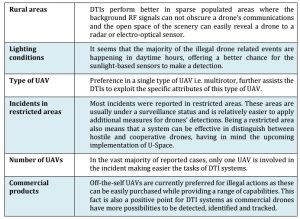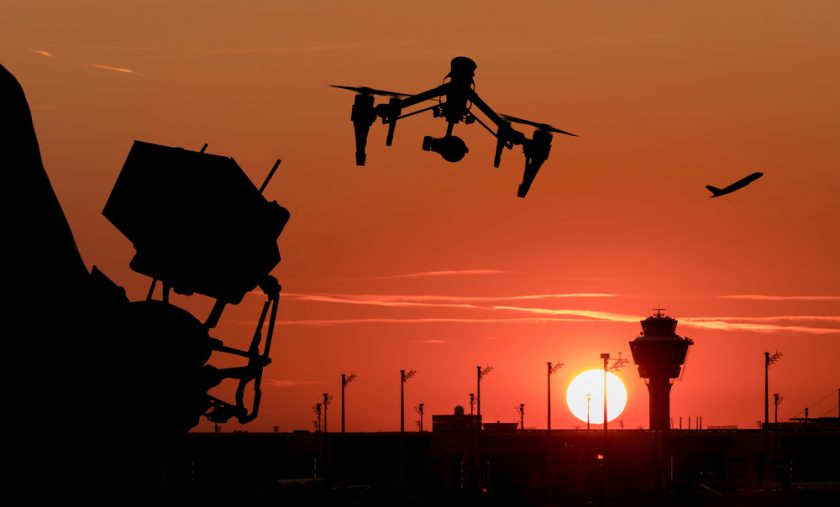By Philip Butterworth-Hayes
The European Committee for Standardisation (CEN) has produced a report which contains new standardised testing procedures for counter-UAS (C-UAS) equipment for government and industry organisations and which highlights the limitations of current technologies and the risks involved in not deploying effective C-UAS systems.
“As U-Space is adopted, the need to detect, identify, and locate both the drones and the operators also increases,” it concludes. “Legislation in member states should safeguard and prevent most drone incidents. Still, if you have a clueless, careless, or criminal drone operator who does not obey the regulations, then the U-Space’s effect could be catastrophic. Collision or crash that will not only damage the drones but also cause damage to the local infrastructure or injure members of the public in the vicinity of the accident.”
The report is the work of the Project COURAGEOUS research consortium, comprising INTERPOL, law enforcement agencies within the European Union and military and academic research organisations. Project members researched the effectiveness of more than 140 C-UAS technologies involved in detection, tracking and identification (DTI) – but not mitigation – and highlighted both the limitations of current technologies and the performance indicators that potential customers will need to evaluate in acquiring this technology, either singularly or in concert with other technologies.
“The development of drones’ DTI technology is a positive phenomenon, but due to the variety of technologies used and their combinations in one system, the end user of such a system may have a growing problem with selecting the C-UAS system appropriate to their needs,” continues the report. “Therefore, it seems logical to systematise the drones’ DTI systems and unify the possibility of choosing such a system for the needs of specific units or critical infrastructures. Due to above needs, it is important to review the C-UAS systems available on the market in terms of framework and technology.”
Over 140 DTI technologies and 823 drone incidents were analysed, with the technology and deployment limitations highlighted. Some of the conclusions are bleak; technology suppliers are either reluctant to provide detailed performance descriptions or the core technologies themselves have cleared defined limits.
“DTIs face several limitations in performing satisfactorily in congested areas. The dense populated RF spectrum challenge the capabilities of drone RF detectors while the crammed buildings offer the appropriate hiding set for a rogue drone.
“Four technologies can be used for detection: microwave radars, IR sensors, frequency monitoring, acoustic sensors. If VIS and thermal imaging cameras do not have additional intelligent image analysis, they cannot be used to detect passing objects. Two out of the seven technologies, i.e., frequency monitoring and acoustic sensors, cannot cope with speeds (if there are additional signal decoding algorithms in frequency monitoring sensors, the speed might be detected – there is no information about this solution in the gathered review). Lidar-laser devices will not detect the direction of drones’ flight. Radars are unable to measure/ give the height of passing drones. Laser-lidar devices and frequency monitoring cannot give the size of the drone.”
“In case of drone tracking methods, C-UAS manufacturers provide very little information. Only 20 manufacturers admit that their product allows this functionality, while only eight indicate the possible angular tracking accuracy.”
“Presence of other UAVs in the area where the incident is taking place is quite possible, rendering the detection of the illegal drones a demanding task for DTIs as these have to distinguish between hostile and harmless drones.
“Custom drones are not being present in the majority of the incidents, nevertheless they constitute a real threat indeed, as their custom set up (e.g. communication frequencies) can elude from certain components of the DTIs.
“The quality, ranges, the multitude of sensors used for C-UAS and finally the choice of a given technology for a specific application is a big challenge. In addition, there are no metrics that would make it possible to compare the necessary parameters of various technologies with each other. Another problem is the possibility of using several different technologies in one C-UAS solution.”
“Information on radar ranges is available only from 43 C-UAS manufacturers. Producers of 45.57% of microwave radars do not provide information about the ranges of their products (out of 79 relevant radars). The radar range is dependent on different factors (Radar Design, RCS of the target, atmospheric conditions), therefore the radar sensor selection is a subject to the use case.”
While the report by its nature focused on technology or reporting limitations it also highlighted the aspects of current drone operations which favour the use of current DTI systems.
Factors that can be exploited in favour of the DTI systems

In terms of incidents, the three most significant iareas are airports, law enforcement/first responders and private/non-corporate environments.. “Most incidents were caused by uninhibited drone pilots who pushed the boundaries of the drone to enter restricted area, no fly zones, or just wanted to see what the drone could do and how it could be utilised,” says the report. “Most drone pilots are novices and just want to capture or utilise the drone in a way that they have seen on social media, in movies, or are just curious about what they can accomplish with the drone.”
The report contains several templates for purchasing authorities to use in comparing performance characteristics of competing technology providers.
For more information
https://www.cencenelec.eu/media/CEN-CENELEC/CWAs/ICT/cwa-18150.pdf




